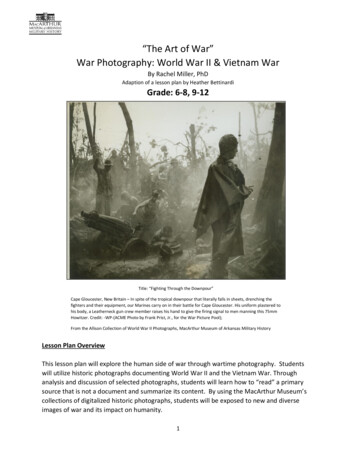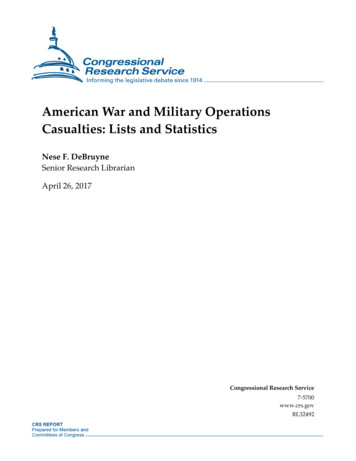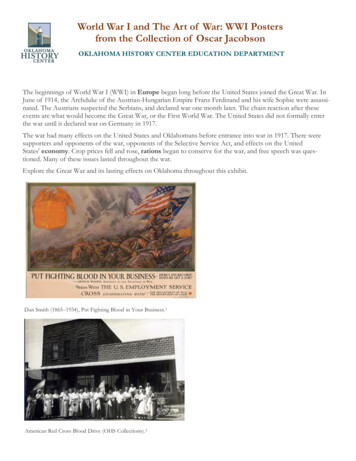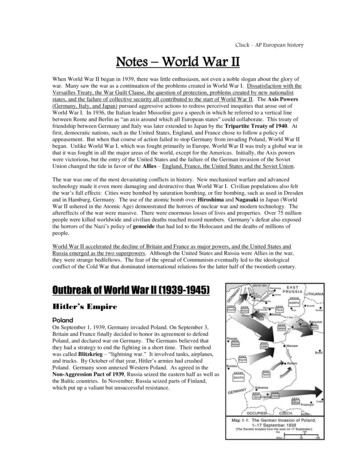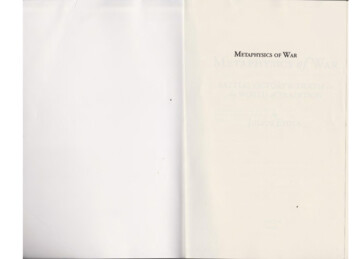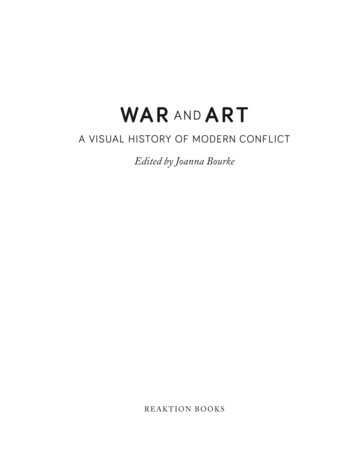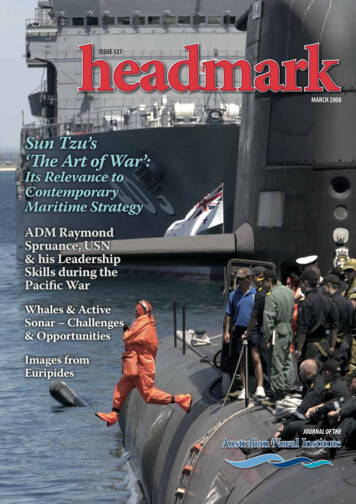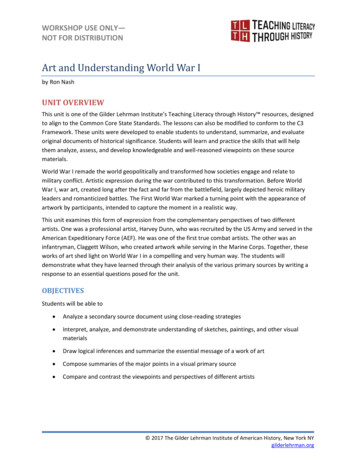
Transcription
WORKSHOP USE ONLY—NOT FOR DISTRIBUTIONArt and Understanding World War Iby Ron NashUNIT OVERVIEWThis unit is one of the Gilder Lehrman Institute’s Teaching Literacy through History resources, designedto align to the Common Core State Standards. The lessons can also be modified to conform to the C3Framework. These units were developed to enable students to understand, summarize, and evaluateoriginal documents of historical significance. Students will learn and practice the skills that will helpthem analyze, assess, and develop knowledgeable and well-reasoned viewpoints on these sourcematerials.World War I remade the world geopolitically and transformed how societies engage and relate tomilitary conflict. Artistic expression during the war contributed to this transformation. Before WorldWar I, war art, created long after the fact and far from the battlefield, largely depicted heroic militaryleaders and romanticized battles. The First World War marked a turning point with the appearance ofartwork by participants, intended to capture the moment in a realistic way.This unit examines this form of expression from the complementary perspectives of two differentartists. One was a professional artist, Harvey Dunn, who was recruited by the US Army and served in theAmerican Expeditionary Force (AEF). He was one of the first true combat artists. The other was aninfantryman, Claggett Wilson, who created artwork while serving in the Marine Corps. Together, theseworks of art shed light on World War I in a compelling and very human way. The students willdemonstrate what they have learned through their analysis of the various primary sources by writing aresponse to an essential questions posed for the unit.OBJECTIVESStudents will be able to Analyze a secondary source document using close-reading strategies Interpret, analyze, and demonstrate understanding of sketches, paintings, and other visualmaterials Draw logical inferences and summarize the essential message of a work of art Compose summaries of the major points in a visual primary source Compare and contrast the viewpoints and perspectives of different artists 2017 The Gilder Lehrman Institute of American History, New York NYgilderlehrman.org
2WORKSHOP USE ONLY—NOT FOR DISTRIBUTIONESSENTIAL QUESTIONS To what extent can art depict and/or distort World War I history? To what extent can the portrayal and framing of art influence viewers’ perspectives of WorldWar I? How does art reflect and document history and memory?NUMBER OF CLASS PERIODS: 2–3GRADE LEVEL: 7–12COMMON CORE STATE STANDARDSCCSS.ELA-Literacy.RH.11-12.2: Determine the central ideas or information of a primary or secondarysource; provide an accurate summary that makes clear the relationships among the key details andideas.CCSS.ELA-Literacy.RH.11-12.6: Evaluate authors’ differing points of view on the same historical event orissue by assessing the authors’ claims, reasoning, and evidence.CCSS.ELA-Literacy.SL.11-12.1: Initiate and participate effectively in a range of collaborative discussions(one-on-one, in groups, and teacher-led) with diverse partners on topics, texts, and issues, building onothers’ ideas and expressing their own clearly and persuasively.CCSS.ELA-Literacy.W.11-12.1: Write arguments to support claims in an analysis of substantive topics ortexts, using valid reasoning and relevant and sufficient evidence.CCSS.ELA-LITERACY.RI.9-10.6: Determine an author’s point of view or purpose in a text and analyze howan author uses rhetoric to advance that point of view or purpose. 2017 The Gilder Lehrman Institute of American History, New York NYgilderlehrman.org
3WORKSHOP USE ONLY—NOT FOR DISTRIBUTIONLESSON 1OVERVIEWStudents will read a secondary source that provides historical context for a selection of paintings by aWorld War I soldier, Claggett Wilson. They will then carefully examine each image, using the questionson an activity sheet, to identify and interpret the images. Their knowledge will be demonstrated throughthe completed activity sheets and class discussion.OBJECTIVESStudents will be able to Demonstrate understanding of both literal and inferential aspects of written text- and imagebased evidence Summarize the essential message of a visual primary source Draw conclusions based on direct evidence found in the visual primary sourceHISTORICAL BACKGROUNDAmerican citizens vigorously debated whether the war that began in Europe in August 1914 was theirsto fight. After refusing for almost three years to engage in the conflict, the United States finally enteredWorld War I on April 6, 1917. When the Americans decided to commit, they did so in a way thattransformed American society and put the nation in a position to become a global superpower.As the nation mobilized for war, the United States broke with its tradition of relying primarily onvolunteers and used conscription to raise the bulk of its military force. One of those conscripted as acombat Marine was the 30-year-old Columbia University art instructor Claggett Wilson.As a first lieutenant, he fought in the trenches in France, including in the month-long battle at BelleauWood in June 1918, perhaps the bloodiest exchange the Americans endured in the war. He was mustardgassed and twice wounded, and at one point spent several days lying in the muddy “no man’s land”between American and German trenches before he was recovered and sent for medical treatment.When the war was over, and he was hospitalized, he painted a series of watercolors depicting hisexperience of war. Some paintings were lost, but in 1919 he repainted roughly forty of them frommemory. The paintings were first exhibited in New York in 1920 to overwhelmingly enthusiastic reviews.A book of the watercolors was published in 1928 with text by Alexander Wolcott of The New Yorker.Eventually, the Smithsonian American Art Museum became the repository for 23 of Wilson’s World WarI watercolors. Wilson, however, never went back to painting about the war.Following his military experience, for which he received the Navy Cross and Croix de Guerre for hisbravery and resilience, and despite his obvious talents as a watercolorist, he moved on to designingfurniture and sets for Broadway plays. It is said that his lungs never completely recovered after themustard-gas attack. 2017 The Gilder Lehrman Institute of American History, New York NYgilderlehrman.org
4WORKSHOP USE ONLY—NOT FOR DISTRIBUTIONIn 1931, he designed the pool house and painted murals on the walls of Ten Chimneys, the famedsummer home of the acclaimed actors Alfred Lunt and Lynne Fontaine. The house was eventuallydeclared a National Historic Landmark—partially for Wilson’s murals. In 1935, he received acclaim fordesigning the sets for the Broadway adaptation of Shakespeare’s The Taming of the Shrew.Wilson also designed costumes for Broadway productions. He gifted many of his stage costumes to NewYork’s Metropolitan Museum of Art and his work is now a permanent part of their Costume Institute.MATERIALS Historical Background: Soldier-Artist Claggett Wilson Details, Description, and Decision activity sheet Paintings by Claggett Wilson. Source: Smithsonian American Art wilson-5422o#1: “Flower of Death--The Bursting of a Heavy Shell--Not as It Looks, but as It Feels andSounds and Smells”o#2: “Dance of Death”o#3: “Symphony of Terror”o#4: “First Attack on the Bois de Belleau, June 6, 1918, at Five O’Clock--3rd Battalion, 5thRegiment of Marines Advancing”o#5: “Early June Morning, Bois de Belleau--Sniper Who Had Been Potted During the Night”o#6: “Front Line Stuff”o#7: “Runner through the Barrage, Bois de Belleau, Chateau Thierry Sector; His Arm ShotAway, His Mind Gone”o#8: “Stragglers--French Wounded in the Retreat of Chateau-Thierry”o#9: “Grenadier Cut Off in the Flaming Woods”o#10: “Salad--A Cleaned-Up Machine-Gun Nest, Bois de Belleau”o#11: “Rosalie, Rosalie! Rosalie Is the Nickname for the French Bayonet”o#12: “Marine Scout on the Lucy-Torcy Road at Dusk, Chateau Thierry Sector”PROCEDURE1. Distribute the Historical Background on Claggett Wilson. “Share read” the Historical Backgroundwith the class. This is done by having the students follow along silently while you begin to readaloud, modeling prosody, inflection, and punctuation. Then ask the class to join in with the readingafter a few sentences while you continue to read aloud, still serving as the model for the class. Thistechnique will support struggling readers as well as English language learners (ELL). 2017 The Gilder Lehrman Institute of American History, New York NYgilderlehrman.org
5WORKSHOP USE ONLY—NOT FOR DISTRIBUTION2. Introduce the Essential Questions: To what extent can art depict and/or distort World War I history? To what extent can the portrayal and framing of art influence viewers’ perspectives of WorldWar I? How does art reflect and document history and memory?3. For the rest of the class period you may choose to have the students do the activity individually, aspartners, or in small groups of no more than three or four students. Depending on the timeavailable, you may choose to provide a selection of the images or assign some image analysis ashomework.4. Distribute paintings #1–#2 by Claggett Wilson and two copies per student of the “Details,Description, and Decision” activity sheet.5. Model the activity with the class for the first two paintings, eliciting answers to the questionsthrough class discussion.6. After analyzing the first two paintings with the class, distribute paintings #3–#12 and the activitysheets (10 per student or group).7. After giving the class enough time to complete the worksheets, reconvene the whole class anddiscuss different interpretations developed by the individual students or groups.ASSESSMENTThe strategy for this lesson will involve an informal assessment of the students’ understanding throughthe completed activity sheets and the class discussion. The students should be able to demonstrateunderstanding of the connection between art and history in the context of World War I. 2017 The Gilder Lehrman Institute of American History, New York NYgilderlehrman.org
6WORKSHOP USE ONLY—NOT FOR DISTRIBUTIONLESSON 2OVERVIEWStudents will read a secondary source that provides historical context for a selection of paintings byWorld War I military artist Harvey Dunn. They will then carefully examine each image, using an activitysheet as a guide, to identify and interpret the images. Their knowledge will be demonstrated throughthe completed activity sheets, class discussion, and a written response to one of the unit’s essentialquestions.OBJECTIVESStudents will be able to Demonstrate understanding of both literal and inferential aspects of text- and image-basedevidence Summarize the essential message of a visual primary source Draw conclusions based on direct evidence found in the visual primary sourceHISTORICAL BACKGROUNDIn February 1918, eight civilian illustrators were inducted as captains in the American ExpeditionaryForce (AEF), the US army that was mobilized to support the French, British, and other Allies in order todefeat the Central Powers. The mission of the AEF Eight, as the artists came to be known, was to make apictorial record of the war for posterity. The artists’ duty was to prepare oil paintings, portraits, andsketches within the war zone for historical purposes. There was no mention of sensationalism orpropaganda. The AEF Eight were to authentically depict the daily life of US soldiers at the front. Inmodem terms they were embedded journalists who were quartered with the troops. They were givenpermission to roam combat areas but were expected to avoid combat engagements.The best-known member of the AEF Eight was Harvey Dunn. He was born and raised on a farm in ruralSouth Dakota. Dunn attended the South Dakota Agricultural College, but soon left to pursue studies atthe Art Institute of Chicago. He became an avid follower of the adventure-book illustrator Howard Pyle.As a result Dunn moved to Wilmington, Delaware, to train with Pyle. Later, Dunn launched his ownstudio in Wilmington and became a successful teacher as well as a successful illustrator of magazines,books, and advertisements.When war was declared, Dunn, at 34, was too old to enlist, but he volunteered for a combat artistposition. He left behind a wife and two young children.The tall and physically imposing Dunn quickly established a reputation as a bold, even foolhardy, combatartist. His work very much centered on frontline action. He was determined to use his skills to show waras it really was. He wanted to be the eyes on the ground for those who would never see war forthemselves. 2017 The Gilder Lehrman Institute of American History, New York NYgilderlehrman.org
7WORKSHOP USE ONLY—NOT FOR DISTRIBUTIONDunn sketched scenes of doughboy life from a dangerous vantage point that apparently contradictedGeneral John Pershing’s order to maintain a safe distance from the battlefield.Dunn worked with charcoal sketches so he could set down his impressions in a rapid-fire manner. Hedevised a unique machine to facilitate his work. A large, flat wooden box containing an unbroken roll ofpaper that was advanced with a turn of a knob enabled Dunn to produce a fresh surface quickly.Dunn’s works from 1918 never gloss over violence and brutality.MATERIALS Historical Background: The AEF Eight and Harvey Dunn Details, Description, and Decision activity sheet Drawings by Harvey Dunno#13: “The Engineer,” National Museum of American ork-wwi/dunno#14: “The Machine Gunner,” National Archives and Records Administration 5: “Doughboy Fighting through Barbed Wire Entanglements,” NARA,https://catalog.archives.gov/id/55234973o#16: “Among the Wreckage. Troops Going Forward at Night,” NARA,https://catalog.archives.gov/id/55222600o#17: “The Tanks at Seicheprey,” US Army Center of Military pripos/wwi1.htmlo#18: “The Flare,” NARA, https://catalog.archives.gov/id/55234863o#19: “The Hand Grenade,” NARA, https://catalog.archives.gov/id/55221478o#20: “The Harvest Moon,” NARA, https://catalog.archives.gov/id/55222553o#21: “Prisoners and Wounded,” NARA, https://catalog.archives.gov/id/55234875o#22: “In the Front Line at Early Morning,” NARA, https://catalog.archives.gov/id/55234785o#23: “Walking Cases,” NARA, https://catalog.archives.gov/id/55222555o#24: “The Home Coming,” NARA, https://catalog.archives.gov/id/55222543 2017 The Gilder Lehrman Institute of American History, New York NYgilderlehrman.org
8WORKSHOP USE ONLY—NOT FOR DISTRIBUTIONPROCEDURE1. Distribute the Historical Background related to the AEF Eight and Harvey Dunn. Share read the textas described in Lesson 1.2. Introduce the following Essential Questions: To what extent can art depict and/or distort World War I history? To what extent can the portrayal and framing of art influence viewers’ perspectives of WorldWar I? How does art reflect and document history and memory?3. For the rest of the class period you may choose to have the students do the lesson individually, aspartners, or in small groups of no more than three or four students.4. Distribute artwork #13–#14 and the “Details, Description, and Decision” activity sheet (2 perstudent).5. Model the activity with the class and have the students answer the questions for each image. Forthe first two images, this will be done as a whole-class activity with discussion.6. After analyzing the first two images with the class, hand out #15–#24 and the “Details, Description,and Decision” activity sheets (10 per student or group).7. After giving the class enough time to complete the worksheets, reconvene the whole class anddiscuss different interpretations developed by the individual students or groups.ASSESSMENTDepending on the amount of time available, you can assign the Exit Card for homework or have thestudents complete it as a class activity on the following day.Based on the visual evidence in the primary sources, completed “Details, Description, and Decision”activity sheets, and class discussions, the students should develop a viewpoint and write a brief essayresponse to one of the unit’s Essential Questions. Remind them to support their answers with visualevidence and analysis based on the historical source materials. To what extent can art depict and/or distort World War I history? To what extent can the portrayal and framing of art influence viewers’ perspectives of WorldWar I? How does art reflect and document history and memory? 2017 The Gilder Lehrman Institute of American History, New York NYgilderlehrman.org
9WORKSHOP USE ONLY—NOT FOR DISTRIBUTIONHANDOUTSHistorical Background: Soldier-Artist Claggett WilsonAmerican citizens vigorously debated whether the war that began in Europe in August 1914 was theirsto fight. After refusing for almost three years to engage in the conflict, the United States finally enteredWorld War I on April 6, 1917. When the Americans decided to commit, they did so in a way thattransformed American society and put the nation in a position to become a global superpower.As the nation mobilized for war, the United States broke with its tradition of relying primarily onvolunteers and used conscription to raise the bulk of its military force. One of those conscripted as acombat Marine was the 30-year-old Columbia University art instructor Claggett Wilson.As a first lieutenant, he fought in the trenches in France, including in the month-long battle at BelleauWood in June 1918, perhaps the bloodiest exchange the Americans endured in the war. He was mustardgassed and twice wounded, and at one point spent several days lying in the muddy “no man’s land”between American and German trenches before he was recovered and sent for medical treatment.When the war was over, and he was hospitalized, he painted a series of watercolors depicting hisexperience of war. Some paintings were lost, but in 1919 he repainted roughly forty of them frommemory. The paintings were first exhibited in New York in 1920 to overwhelmingly enthusiastic reviews.A book of the watercolors was published in 1928 with text by Alexander Wolcott of The New Yorker.Eventually, the Smithsonian American Art Museum became the repository for 23 of Wilson’s World WarI watercolors. Wilson, however, never went back to painting about the war.Following his military experience, for which he received the Navy Cross and Croix de Guerre for hisbravery and resilience, and despite his obvious talents as a watercolorist, he moved on to designingfurniture and sets for Broadway plays. It is said that his lungs never completely recovered after themustard-gas attack.In 1931, he designed the pool house and painted murals on the walls of Ten Chimneys, the famedsummer home of the acclaimed actors Alfred Lunt and Lynne Fontaine. The house was eventuallydeclared a National Historic Landmark—partially for Wilson’s murals. In 1935, he received acclaim fordesigning the sets for the Broadway adaptation of Shakespeare’s The Taming of the Shrew.Wilson also designed costumes for Broadway productions. He gifted many of his stage costumes to NewYork’s Metropolitan Museum of Art and his work is now a permanent part of their Costume Institute. 2017 The Gilder Lehrman Institute of American History, New York NYgilderlehrman.org
10WORKSHOP USE ONLY—NOT FOR DISTRIBUTIONDetails, Description, and DecisionImage #PeopleObjectsDescriptive Details About:Descriptive Details About:Identify the person/people in this painting.Identify the object(s) in this painting.Descriptive Summary Sentence:Descriptive Summary Sentence:Action/ActivityOverall AssessmentDescriptive Details About:Decision:Identify the action/activity in this painting.What have I learned about World War I from thispainting?Descriptive Summary Sentence: 2017 The Gilder Lehrman Institute of American History, New York NYgilderlehrman.org
11WORKSHOP USE ONLY—NOT FOR DISTRIBUTIONHistorical Background: The AEF Eight and Harvey DunnIn February 1918, eight civilian illustrators were inducted as captains in the American ExpeditionaryForce (AEF), the US army that was mobilized to support the French, British, and other Allies in order todefeat the Central Powers. The mission of the AEF Eight, as the artists came to be known, was to make apictorial record of the war for posterity. The artists’ duty was to prepare oil paintings, portraits, andsketches within the war zone for historical purposes. There was no mention of sensationalism orpropaganda. The AEF Eight were to authentically depict the daily life of US soldiers at the front. Inmodem terms they were embedded journalists who were quartered with the troops. They were givenpermission to roam combat areas but were expected to avoid combat engagements.The best-known member of the AEF Eight was Harvey Dunn. He was born and raised on a farm in ruralSouth Dakota. Dunn attended the South Dakota Agricultural College, but soon left to pursue studies atthe Art Institute of Chicago. He became an avid follower of the adventure-book illustrator Howard Pyle.As a result Dunn moved to Wilmington, Delaware, to train with Pyle. Later, Dunn launched his ownstudio in Wilmington and became a successful teacher as well as a successful illustrator of magazines,books, and advertisements.When war was declared, Dunn, at 34, was too old to enlist, but he volunteered for a combat artistposition. He left behind a wife and two young children.The tall and physically imposing Dunn quickly established a reputation as a bold, even foolhardy, combatartist. His work very much centered on frontline action. He was determined to use his skills to show waras it really was. He wanted to be the eyes on the ground for those who would never see war forthemselves.Dunn sketched scenes of doughboy life from a dangerous vantage point that apparently contradictedGeneral John Pershing’s order to maintain a safe distance from the battlefield.Dunn worked with charcoal sketches so he could set down his impressions in a rapid-fire manner. Hedevised a unique machine to facilitate his work. A large, flat wooden box containing an unbroken roll ofpaper that was advanced with a turn of a knob enabled Dunn to produce a fresh surface quickly.Dunn’s works from 1918 never gloss over violence and brutality. 2017 The Gilder Lehrman Institute of American History, New York NYgilderlehrman.org
12WORKSHOP USE ONLY—NOT FOR DISTRIBUTIONExit CardBased on the visual evidence in the primary sources, the completed “Details, Description, and Decision”activity sheets, and the class discussions, develop a viewpoint and write a brief essay response to anyone of the following questions. Support your viewpoint and response with visual evidence and analysisbased on the historical source materials.Choice No. 1: “To what extent can art depict and/or distort WWI history?”orChoice No. 2: “To what extent can the portrayal and ‘framing’ of art influence viewers’ perspectives andunderstandings of WWI?”orChoice No. 3: “How accurately does art reflect and document history and memory? 2017 The Gilder Lehrman Institute of American History, New York NYgilderlehrman.org
13WORKSHOP USE ONLY—NOT FOR DISTRIBUTION#1 2017 The Gilder Lehrman Institute of American History, New York NYgilderlehrman.org
14WORKSHOP USE ONLY—NOT FOR DISTRIBUTION#2 2017 The Gilder Lehrman Institute of American History, New York NYgilderlehrman.org
15WORKSHOP USE ONLY—NOT FOR DISTRIBUTION#3 2017 The Gilder Lehrman Institute of American History, New York NYgilderlehrman.org
16WORKSHOP USE ONLY—NOT FOR DISTRIBUTION#4 2017 The Gilder Lehrman Institute of American History, New York NYgilderlehrman.org
17WORKSHOP USE ONLY—NOT FOR DISTRIBUTION#5 2017 The Gilder Lehrman Institute of American History, New York NYgilderlehrman.org
18WORKSHOP USE ONLY—NOT FOR DISTRIBUTION#6 2017 The Gilder Lehrman Institute of American History, New York NYgilderlehrman.org
19WORKSHOP USE ONLY—NOT FOR DISTRIBUTION#7 2017 The Gilder Lehrman Institute of American History, New York NYgilderlehrman.org
20WORKSHOP USE ONLY—NOT FOR DISTRIBUTION#8 2017 The Gilder Lehrman Institute of American History, New York NYgilderlehrman.org
21WORKSHOP USE ONLY—NOT FOR DISTRIBUTION#9 2017 The Gilder Lehrman Institute of American History, New York NYgilderlehrman.org
22WORKSHOP USE ONLY—NOT FOR DISTRIBUTION#10 2017 The Gilder Lehrman Institute of American History, New York NYgilderlehrman.org
23WORKSHOP USE ONLY—NOT FOR DISTRIBUTION#11 2017 The Gilder Lehrman Institute of American History, New York NYgilderlehrman.org
24WORKSHOP USE ONLY—NOT FOR DISTRIBUTION#12 2017 The Gilder Lehrman Institute of American History, New York NYgilderlehrman.org
25WORKSHOP USE ONLY—NOT FOR DISTRIBUTION#13 2017 The Gilder Lehrman Institute of American History, New York NYgilderlehrman.org
26WORKSHOP USE ONLY—NOT FOR DISTRIBUTION#14 2017 The Gilder Lehrman Institute of American History, New York NYgilderlehrman.org
27WORKSHOP USE ONLY—NOT FOR DISTRIBUTION#15 2017 The Gilder Lehrman Institute of American History, New York NYgilderlehrman.org
28WORKSHOP USE ONLY—NOT FOR DISTRIBUTION#16 2017 The Gilder Lehrman Institute of American History, New York NYgilderlehrman.org
29WORKSHOP USE ONLY—NOT FOR DISTRIBUTION#17 2017 The Gilder Lehrman Institute of American History, New York NYgilderlehrman.org
30WORKSHOP USE ONLY—NOT FOR DISTRIBUTION#18 2017 The Gilder Lehrman Institute of American History, New York NYgilderlehrman.org
31WORKSHOP USE ONLY—NOT FOR DISTRIBUTION#19 2017 The Gilder Lehrman Institute of American History, New York NYgilderlehrman.org
32WORKSHOP USE ONLY—NOT FOR DISTRIBUTION#20 2017 The Gilder Lehrman Institute of American History, New York NYgilderlehrman.org
33WORKSHOP USE ONLY—NOT FOR DISTRIBUTION#21 2017 The Gilder Lehrman Institute of American History, New York NYgilderlehrman.org
34WORKSHOP USE ONLY—NOT FOR DISTRIBUTION#22 2017 The Gilder Lehrman Institute of American History, New York NYgilderlehrman.org
35WORKSHOP USE ONLY—NOT FOR DISTRIBUTION#23 2017 The Gilder Lehrman Institute of American History, New York NYgilderlehrman.org
36WORKSHOP USE ONLY—NOT FOR DISTRIBUTION#24 2017 The Gilder Lehrman Institute of American History, New York NYgilderlehrman.org
World War I remade the world geopolitically and transformed how societies engage and relate to military conflict. Artistic expression during the war contributed to this transformation. Before World War I, war art, created long after the fact and far from the battlefield, largely depicted heroic military leaders and romanticized battles.

